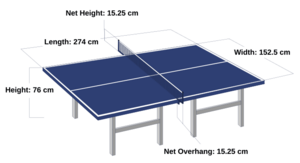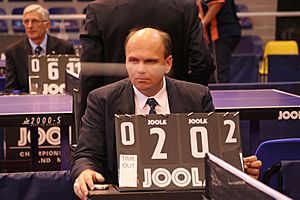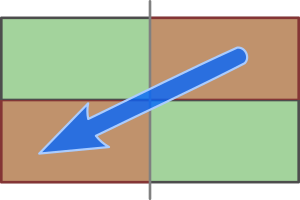Table tennis facts for kids
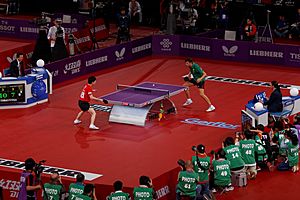
Table tennis at the highest level
|
|
| Highest governing body | ITTF |
|---|---|
| First played | 1880s Victorian England |
| Characteristics | |
| Contact | No |
| Team members | Single or doubles |
| Type | Racquet sport, indoor |
| Equipment | Poly, 40 mm (1.57 in), 2.7 g (0.095 oz) |
| Glossary | Glossary of table tennis |
| Presence | |
| Olympic | Since 1988 |
| Paralympic | Since inaugural 1960 Summer Paralympics |
Table tennis, also known as Ping Pong, is a super popular sport played all over the world! You can play it with two or four people on a special table. To play, you use a small bat (or paddle) and a light, bouncy ball. You also need a net across the middle of the table. This exciting game was first invented in England way back in the 1880s.
The International Table Tennis Federation (ITTF) is the main group that organizes table tennis around the globe. It was started in 1926. Table tennis became an Olympic sport in 1988, which was a big deal! Today, many of the world's best players come from China.
- In China, Hong Kong, and Taiwan, the sport is officially called 乒乓球 (Ping Pang Qiu).
- In Japan, it's known as 卓球 (Takkyu).
Contents
What Do You Need to Play Table Tennis?
The Ball
The rules say the ball must weigh about 2.7 grams and be 40 millimeters wide. It should bounce well, too! When dropped from 30.5 cm, it should bounce up 24 to 26 cm. Since 2015, balls are made from a special plastic, not celluloid. They are either white or orange and have a dull, non-shiny finish. The color of the ball is chosen to make it easy to see against the table and background. For example, a white ball works best on a green or blue table.
Some balls have a star rating, usually from one to three stars, with three being the best. But for official games, the ball must be approved by the ITTF. You can usually see the ITTF approval printed right on the ball.
The Table
The table is 2.74 meters long, 1.525 meters wide, and 76 centimeters high. It can be made of any strong material that gives a good, even bounce. If you drop a standard ball from 30 cm, it should bounce about 23 cm high. The playing surface is dark and not shiny. A net divides the table into two halves, and it's 15.25 cm high. The ITTF only approves wooden tables or ones made from wood-like materials. Sometimes, you might see concrete tables with steel nets in parks.
The Racket (or Bat/Paddle)
Players use a racket made of wood with rubber on one or both sides. The ITTF calls it a "racket," but in Britain, it's often called a "bat," and in the U.S. and Canada, a "paddle."
The wooden part of the racket is called the "blade." It usually has between one and seven layers of wood. Sometimes, other materials like carbon fiber are added. At least 85% of the blade's thickness must be natural wood. Popular woods include balsa and cypress. Rackets are usually about 17 cm long and 15 cm wide.
The rules allow different types of rubber on each side of the racket. Some rubbers create a lot of spin, while others make the ball go faster or even stop spin. A player might have a spinny rubber on one side and a non-spinny one on the other. By quickly flipping the racket, they can hit different kinds of shots! To make it fair, one side of the racket must be red and the other black. Players can check their opponent's racket before a game. Even though the game is fast, you can usually see which side of the racket was used to hit the ball. Unless it gets damaged, you can't swap rackets during a match.
How to Play the Game
Starting a Game
To decide who serves first, players often do a coin toss. Another common way is for one player to hide the ball in one hand under the table. The other player guesses which hand it's in. The winner of the guess gets to choose if they want to serve, receive, or pick which side of the table they want.
Serving and Returning the Ball
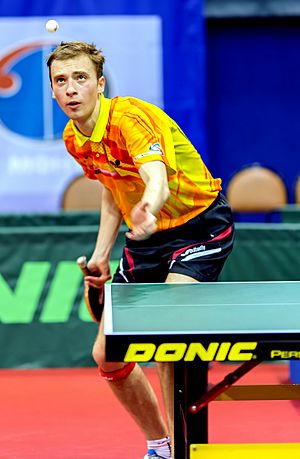
To serve, the player holds the ball on their open hand (the one not holding the racket). They toss the ball straight up at least 16 cm high without spinning it. As the ball comes down, the server hits it with the racket. The ball must first bounce on their side of the table, then go over the net, and bounce on the opponent's side. In friendly games, some people don't toss the ball high, but this is against the rules.
The ball must stay behind the end line and above the table during the serve. The server cannot hide the ball with their body or clothes. The opponent and the umpire (referee) must always see the ball clearly. If the umpire thinks a serve is not legal, they might give a warning. If it happens again, the opponent gets a point.
If the serve is good, the other player must hit the ball back before it bounces a second time on their side. The ball must go over the net and land on the server's side. After that, players take turns hitting the ball back and forth until one person can't make a good return. Returning the serve can be tricky because the server can use different spins and speeds.
What is a "Let"?
A "let" means the point doesn't count, and you play it again. This happens if:
- The ball touches the net during a serve, but the serve was otherwise good.
- The player receiving the serve isn't ready.
- Something outside the game (like a loud noise) stops play.
- The umpire stops the game for any reason.
A serve is also a "let" if the ball hits the server's side, doesn't go past the edge, or hits the table edge and then the net.
Scoring Points
You score a point if:
- Your opponent doesn't make a correct serve or return.
- After your opponent hits the ball, it touches anything other than the net before you hit it.
- The ball goes over your opponent's side of the table or past their end line without touching their side.
- Your opponent blocks the ball before it bounces on their side.
- Your opponent hits the ball twice in a row. (But if it hits your hand or fingers and then your racket, that's okay!)
- Your opponent hits the ball with a part of the racket that isn't covered with rubber.
- Your opponent moves the table or touches the net.
- Your opponent's free hand touches the table.
- Under a special "expedite system," your opponent makes 13 returns, and you haven't won the point yet.
- Your opponent gets a second warning from the umpire in the same match. If they get a third warning, you get 2 points!
A game is usually won by the first player to score 11 points. But if both players reach 10 points, then one player must get a lead of 2 points to win (like 12-10 or 13-11). A match is made up of an odd number of games, usually the best of five or seven games in competitions.
Changing Servers and Sides
Players take turns serving every two points. This continues until the end of the game. However, if both players reach 10 points (called "deuce"), then each player serves for only one point at a time. The player who served first in one game will receive first in the next game.
After each game, players switch sides of the table. In the very last game of a match (like the fifth game in a best-of-five match), players switch sides again when one player scores 5 points.
Playing Doubles
Besides playing by yourself, you can also play table tennis with a partner in doubles! Both singles and doubles are played in big competitions like the Olympics.
In doubles, most of the rules are the same as singles, except for these:
Serving in Doubles
- The table has a line down the middle that creates two "boxes" on each side. When serving in doubles, the ball must bounce first in your right-hand box, then go over the net, and bounce in your opponent's right-hand box (which is the far-left box for you). If the serve isn't correct, the other team gets a point.
Order of Play
- Players must hit the ball in a specific order. If Team A (A and B) plays Team X (X and Y), and A serves to X, the order of hitting the ball is A → X → B → Y. This continues until someone misses.
- When it's time for a new serve, the player who just received the serve becomes the server. And the partner of the previous server becomes the receiver. So, if the order was A → X → B → Y, the next order would be X → B → Y → A.
- In later games of a match, the game starts with the reverse order of play.
- In the final game, when one team reaches 5 points, the teams switch sides of the table. They also change the order of who receives the ball to keep things fair.
Expedite System
If a game is taking a very long time (more than 10 minutes) and not many points have been scored (fewer than 18), a special rule called the "expedite system" might start. The umpire will stop the game, and then players serve for only one point at a time. Under this system, the server must win the point before the opponent makes 13 returns in a row. If the opponent makes 13 returns, they get the point! This rule helps to make sure games don't go on forever, especially with players who play very defensively. Once this system starts, it stays in effect for the rest of the match.
Related Pages
Images for kids
-
Chinese penhold (Ma Lin)
See also
 In Spanish: Tenis de mesa para niños
In Spanish: Tenis de mesa para niños



